Reclaim Waste Can Be Fun For Anyone
Reclaim Waste Can Be Fun For Anyone
Blog Article
The Only Guide to Reclaim Waste
Table of ContentsThe 15-Second Trick For Reclaim WasteThings about Reclaim WasteGetting My Reclaim Waste To WorkGetting The Reclaim Waste To WorkReclaim Waste for Beginners
Explore the types, events, and kinds of fluid waste. Residential sewage waste refers to the waste and products from a domestic sewage-disposal tank. This kind of waste is created by people in residences, schools, and various other structures. This only includes sewage-disposal tanks that have a drain field. The proper management and disposal of domestic sewage waste call for fluid waste to be moved to a sewer treatment plant where the appropriate techniques and devices are related to detoxify and get rid of waste.
Commercial waste frequently consists of prospective threats, such as flammable products or a mix of fluid and strong waste items, and needs a much more advanced and comprehensive disposal procedure. The disposal of commercial waste typically includes the purification of waste prior to transport to make certain secure and correct disposal. Hazardous waste is produced from by-products and runoff of commercial procedures and manufacturing.
This kind of waste can not use the same sewage management transport or procedures as septic or business fluids. The commercial waste monitoring procedure calls for the evaluation and testing of liquid waste prior to it undergoes the disposal procedure (industrial wastewater treatment). Runoff waste is the liquid waste that comes from runoff and excess stormwater in extremely populated areas or cities
Overflow waste can create contamination and flooding if not handled properly. Ensuring proper waste monitoring can prevent catastrophes and reduce ecological damage.
Little Known Facts About Reclaim Waste.
Contact PROS Solutions today to find out about our waste monitoring and disposal solutions and the appropriate methods to take care of the fluid waste you produce.
(https://filesharingtalk.com/members/604691-reclaimwaste1)This supposed 'wastewater' is not just a crucial source however, after therapy, will be released to our land, rivers or the ocean. Utilized water from toilets, showers, bathrooms, kitchen area sinks, washings and industrial processes is understood as wastewater.

water utilized to cool down machinery or clean plant and equipment). Stormwater, a form of wastewater, is runoff that streams from agricultural and city areas such as roofs, parks, gardens, roadways, courses and seamless gutters right into stormwater drains pipes, after rain. Stormwater moves unattended directly to local creeks or rivers, ultimately reaching the sea.
The Reclaim Waste Statements
In Queensland, many wastewater is dealt with at sewer treatment plants. Wastewater is carried from domestic or industrial sites via a system of sewers and pump terminals, understood as sewerage reticulation, to a sewer treatment plant.
The Department of Natural Resources advises regional governments regarding handling, operating and preserving sewerage systems and treatment plants. In unsewered locations, city governments might require householders to set up private or family sewer therapy systems to treat residential wastewater from bathrooms, cooking areas, restrooms and laundries. The Division of Natural Resources authorizes making use of home systems when they are shown to be reliable.
Many stormwater obtains no therapy. In some brand-new class, treatment of some stormwater to remove clutter, sand and crushed rock has started utilizing gross toxin traps. Wastewater therapy takes place in 4 stages: Gets rid of solid issue. Larger solids, such as plastics and various other items wrongly discharged to sewers, are eliminated when wastewater is gone through screens.
Wastewater then moves into big containers where solids work out and are gotten rid of as sludge. Oil and residue are skimmed from the surface. Utilizes small living microorganisms recognizes as micro-organisms to break down and remove staying liquified wastes and great particles. Micro-organisms and wastes are included in the sludge. Gets rid of nitrogen and phosphorus nutrients that can cause algal blossoms in our waterways and threaten aquatic life.
Getting My Reclaim Waste To Work
Nutrient elimination is not offered at all sewer treatment plants due to the fact that it needs pricey specialised tools. Clear liquid effluent produced after therapy may still have disease-causing micro-organisms - liquid waste disposal melbourne.

This typically suggests wastewater needs to be dealt with or pollutants removed before it can be released to waterways. Most wastewater streams into the sewage system. Under the Act, more information city governments administer approvals and licences for eco pertinent tasks (Periods) involving wastewater releases that may have a local impact. The division provides authorizations and licences to Periods involving wastewater releases that may have a regional or statewide effect.
Examine This Report about Reclaim Waste
Monitoring supplies valid information concerning water quality and can verify that licence problems are being satisfied. The details acquired with tracking offers the basis for making water high quality decisions.
Report this page